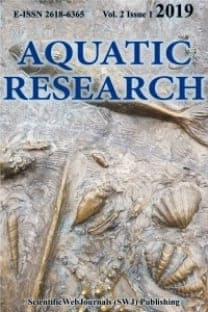EFFECT OF DIFFERENT DIETS ON GROWTH PERFORMANCE AND SURVIVAL OF EUROPEAN PERCH (Perca fluviatilis L.) CULTIVATED IN RECIRCULATING SYSTEM DURING TRANSITION FROM LIVE FOOD TO FORMULATED FEED
___
Baranek, V., Dvorak, J., Kalenda, V., Mares, J., Zrustova, J., Spurny, P. (2007). Comparison of two weaning metods of juvenile pikeperch Sander lucioperca from natural diet to. Ustva Zoologie, 1, 6-13.Bodis, M., Kucska, B., Bercsenyi, M. (2007). The effect of different diets on the growth and mortality of juvenile pikeperch (Sander lucioperca) in the transition from live food to formulated feed. Aquaculture International, 15, 83-90.
Brännäs, E., Alanärä, A., Magnhagen, C. (2001). The social behaviour of fish. In: Keeling, L.J., Gonyou, H.W. (Eds.), Social Behaviour in Farm Animals. CABI publishing, New York, pp. 275-304. ISBN 0851997171
De Silva, S., Anderson, T. (1994). Fish Nutrition in Aquaculture. Chapman & Hall, London. 319 pp. ISBN 978-0-412-55030-0
Hubenova, T., Zaykov, А., Katcarov, E., Terziiski, D. (2014). The influence of stocking density on the growth and survival of pikeperch fry (Sander lucioperca L.) during weaning from natural to dry feed. Animal science, LI, 4.
Jobling, M. (1994). Fish Bioenergetics. Chapman & Hall, London. 300 pp. ISBN 978-0-412-58090-1
Policar, T., Stejskal, V., Kristan, J., Podhorec, P., Svinger, V., Blaha, M. (2013). The effect of fish size and stocking density on the weaning success of pond-cultured pikeperch Sander lucioperca L. juveniles. Aquaculture International, 21(4), 869-882.
Regulation № 4/20.10.2000. Concerning the quality of the waters for fish farming and for rearing of shell organisms. Ministry of Environment and Waters, Ministry of Agriculture and forests and Ministry of Health (OG, issue 88/ 27.10.2000).
Rowland, S.J., Allan, G.L., Mifsud, C., Nixon, M., Boyd, P., Glendenning, D. (2005). Development of a feeding strategy for silver perch, Bidyanus bidyanus (Mitchell), based on restricted rations. Aquaculture Research, 36, 1429-1441.
Todorov, M., Ivancheva, E. (1992). Manual for works in fish-farming. 86 pp. (Bg). ISBN 954-05-0188-1
Toner, D., Rougeot, C. (2008). Farming of Eurasian Perch Volume 1: Juvenile production. Aquaculture Explained, № 24. Dublin. Retrieved from http://hdl.handle.net/2268/23392 (accessed 15.12.17)
Zakes, Z. (1997). Effect of stock density on the survival, cannibalism and growth of summer fry of European pikeperch (Stizostedion lucioperca L.) feed artificial diets in controlled conditions. Aschives of Polish Fisheri, 5(2), 305-311.
Zaykov, А. & Staykov, Y. (2013). Technologies in the freshwater aquaculture. Academic publisher Trakia University. ISBN 978-945-338-058-9.
Zhelyazkov, G. (2015). The effect of stocking density on some hydrochemical parameters and growth traits in European perch (Perca fluviatilis L.), cultivated in a recirculation system. Agriculture Science and Technology, 7(2), 238-241.
- ISSN: 2618-6365
- Yayın Aralığı: 4
- Başlangıç: 2018
- Yayıncı: Nuray ERKAN ÖZDEN
Clementain C. ZVAVAHERA, Vimbai R. HAMANDİSHE, Petronella T. SAİDİ, Venancio E. IMBAYARWO-CHİKOSİ, Tamuka NHİWATİWA
MURAT YİĞİT, Michael OSİENSKİ, Judson DECEW, Barbaros ÇELİKKOL, OSMAN SABRİ KESBİÇ, Mustafa KARGA, ÜMİT ACAR, Evrim KURTAY, Barış ÖZALP, Musa BULUT, Ümüt YİĞİT, Nic TAYLOR, Robert L. DWYER
A CONTEMPORARY ANALYSIS ON FISH FARMS AND THE SAFETY OF NAVIGATION
Süleyman ÖZDEMİR, Hilal SÖYLEYİCİ, Zekiye Birinci ÖZDEMİR, Uğur ÖZSANDIKÇI, Ferhat BÜYÜKDEVECİ
